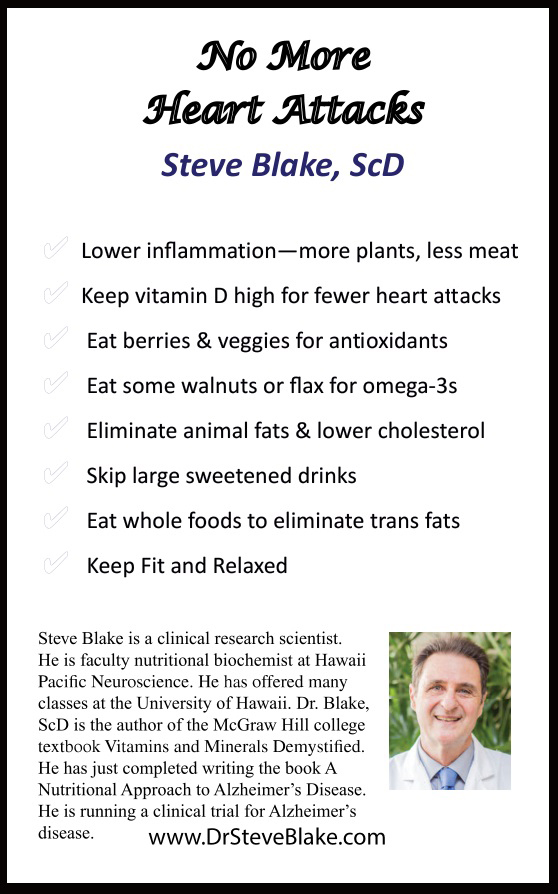
No More Heart Attacks
Dr. Steve Blake, ScD
Ferbruary 2016
Let's get started getting rid of heart attacks in America.
Heart attacks are not really necessary or automatic
as we age. You can take steps to greatly
lower your risk of heart attacks. You can l
ower your risk of a heart attack
nearly to zero, perhaps even to zero.
$9.95 to download the entire 133 page PDF book. Click below:
Please see the video below for a brief preview of the book:
Please see below for the table of contents.
Contents
Introduction 2
Table of Contents 5
List of Figures 8
Chapter 1: Heart attacks and strokes 9
How to NOT Get a Heart Attack 10
Are heart attacks really necessary? 14
Is there a place with NO heart attacks? 15
Unclogging arteries 17
Blood flow to the heart muscle 20
Want to reduce your risk of a heart attack by 92%? 22
Chapter 2: Inflammation and arterial disease 23
Quercetin, a plant-based anti-inflammatory 24
How quercetin quenches inflammation 25
Genistein 27
Indole-3-carbinol 28
Food that increases inflammation 29
Endotoxins 30
Neu5Gc 31
Chapter 3: Higher vitamin D means fewer heart attacks 33
Chapter 4: Antioxidants 36
Antioxidants in food 38
Antioxidants made in our bodies 40
Oxidation of LDL 41
Vitamin E to protect LDL and arteries 42
Vitamin E, prostacyclins and reduced arterial plaque 46
Sources of vitamin E 47
A very low fat diet 48
Absorption of antioxidants on a very low-fat diet 49
Diets high and low in antioxidants 52
Antioxidants that we make in our bodies 54
Chapter 5: Omega-3 fatty acids and heart disease 57
Sources of omega-3 fatty acids 59
Increasing inflammation with arachidonic acid 61
What about fish oil? 63
Contamination of fish oil 63
Rancid fish oil 65
Production of EPA and DHA in our bodies 66
Chapter 6: Total cholesterol and heart attack risk 68
Four steps to reduce cholesterol 69
Heart attack risk and cholesterol on different diets 70
Fats in food and fats in our bloodstream 76
Where do saturated fats come from? 79
How does excess saturated fat raise heart attack risk? 81
Oxidized dietary cholesterol and damaged arteries 84
Lower cholesterol using phytosterols 88
Fiber and blood cholesterol 91
Chapter 7: Sugar and heart attack risk 93
Chapter 8: Trans Fatty acids and Heart Attacks 95
Understanding trans fats 96
Dietary sources of trans-fatty acids 97
Alternatives to partially hydrogenated oils 101
Frying 101
Snack foods 102
Bakery products 103
The risks of reducing trans fats 104
Palm and other tropical oils 104
Animal fats to replace hydrogenated oils 105
Designer oils 105
Choosing food low in trans-fatty acids 106
Worldwide variation in trans-fatty acid intake 107
Trans fats in food in America 108
Labeling deceit 110
Absorption and metabolism of trans-fatty acids 111
Heart disease and trans-fatty acids 113
Trans fats and blood lipids 114
Diabetes and trans-fatty acids 115
Trans-fatty acids in infants and children 117
Trans-fatty acids from dairy products and beef 118
Trans-fatty acids in animal vs. vegetable fats 121
Trans-fatty acid summary 123
Chapter 9: Activity and fitness 124
Chapter 10: Stress reduction and relaxation 127
Peer-Reviewed Reference Citations 130
